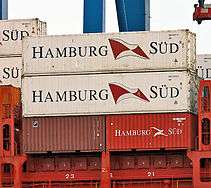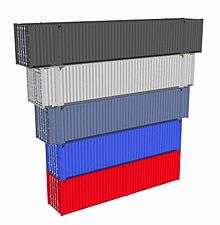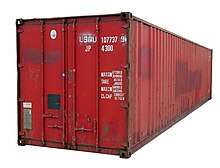Twenty-foot equivalent unit
The twenty-foot equivalent unit (often TEU or teu) is an inexact unit of cargo capacity often used to describe the capacity of container ships and container terminals.[1] It is based on the volume of a 20-foot-long (6.1 m) intermodal container, a standard-sized metal box which can be easily transferred between different modes of transportation, such as ships, trains and trucks.[1]
---No%2C1_%E3%80%90_Pictures_taken_in_Japan_%E3%80%91.jpg)

The container is defined by its length though there is a lack of standardisation in regard to height, ranging between 4 feet 3 inches (1.30 m) and 9 feet 6 inches (2.90 m), with the most common height being 8 feet 6 inches (2.59 m).[2] Also, it is common to designate 45-foot (13.7 m) containers as 2 TEU, rather than 2.25 TEU.
Forty-foot equivalent unit

The standard intermodal container is designated as twenty feet long (6.1 m) and 8 feet (2.44 m) wide.[1] Additionally there is a standard container with the same width but a doubled length of forty feet called a 40-foot (12.2 m) container, which equals one forty-foot equivalent unit (often FEU or feu) in cargo transportation (considered to be two TEU, see below).
In order to allow stacking of these types a forty-foot intermodal container has an exact length of 40 feet (12.192 m), while the standard twenty-foot intermodal container is slightly shorter having an exact length of 19 feet 10.5 inches (6.058 m). The twistlocks on a ship are put at a distance so that two standard twenty-foot containers have a gap of three inches which allows a single forty-foot container to be put on top.[3]
The forty-foot containers have found wider acceptance, as they can be pulled by semi-trailer truck. The length of such a combination is within the limits of national road regulations in many countries, requiring no special permission. As some road regulations allow longer trucks, there are also variations of the standard forty-foot container — in Europe and most other places a container of 45 feet (13.72 m) may be pulled as a trailer. Containers with a length of 48 feet (14.63 m) or 53 feet (16.15 m) are restricted to road transport in the United States. Although longer than 40 feet, these variants are put in the same class of forty-foot equivalent units.
Equivalence
| Length | Width | Height | Internal Volume | TEU |
|---|---|---|---|---|
| 20 ft (6.1 m) | 8 ft (2.44 m) | 8 ft 6 in (2.59 m) | 1,172 cu ft (33.2 m3) | 1[6] |
| 40 ft (12.2 m) | 8 ft (2.44 m) | 8 ft 6 in (2.59 m) | 2,389 cu ft (67.6 m3) | 2[6] |
| 48 ft (14.6 m) | 8 ft (2.44 m) | 8 ft 6 in (2.59 m) | 3,264 cu ft (92.4 m3) | 2.4 |
| 53 ft (16.2 m) | 8 ft (2.44 m) | 8 ft 6 in (2.59 m) | 3,604 cu ft (102.1 m3) | 2.65 |
| High cube | ||||
| 20 ft (6.1 m) | 8 ft (2.44 m) | 9 ft 6 in (2.90 m) | 1,520 cu ft (43 m3) | 1[2] |
| Half height | ||||
| 20 ft (6.1 m) | 8 ft (2.44 m) | 4 ft 3 in (1.30 m) | 680 cu ft (19.3 m3) | 1[2] |
The carrying capacity of a ship is usually measured by mass (the deadweight tonnage) or by volume (the net register tonnage). Deadweight tonnage is generally measured now in metric tons (tonnes). Register tons are measured in cu. ft, with one register ton equivalent to 100 cubic feet (2.83 m3).
As the TEU is an inexact unit, it cannot be converted precisely into other units. The related unit forty-foot equivalent unit, however, is defined as two TEU. The most common twenty-foot container occupies a space 20 feet (6.1 m) long, 8 feet (2.44 m) wide, and 8 feet 6 inches (2.59 m) high, with an allowance externally for the corner castings; the internal volume is 1,172 cubic feet (33.2 m3). However, both 9-foot-6-inch-tall (2.90 m) High cube and 4-foot-3-inch (1.30 m) half height containers are also reckoned as 1 TEU.[2] This gives a volume range of 680 to 1,520 cubic feet (19 to 43 m3) for one TEU.
While the TEU is not itself a measure of mass, some conclusions can be drawn about the maximum mass that a TEU can represent. The maximum gross mass for a 20-foot (6.1 m) dry cargo container is 24,000 kilograms (53,000 lb).[7] Subtracting the tare mass of the container itself, the maximum amount of cargo per TEU is reduced to approximately 21,600 kilograms (47,600 lb).[7]
Similarly, the maximum gross mass for a 40-foot (12.2 m) dry cargo container (including the 9-foot-6-inch-high (2.90 m) cube container) is 30,480 kilograms (67,200 lb).[7] After correcting for tare weight, this gives a cargo capacity of 26,500 kilograms (58,400 lb).[7]
Twenty-foot, "heavy tested" containers are available for heavy goods such as heavy machinery. These containers allow a maximum weight of 67,200 pounds (30,500 kg), an empty weight of 5,290 pounds (2,400 kg), and a net load of 61,910 pounds (28,080 kg).
See also
References
- Rowlett, 2004.
- "Container Shipping". damovers.com. DaMovers.com. Archived from the original on 2008-03-27. Retrieved 2008-03-22.
- "How Does It Work?". Retrieved 26 October 2015.
- "Namegiving of newbuilding L 203". Odense Steel Shipyard. 2006-12-08. Archived from the original on July 13, 2007.
- Koepf, Pam (2006). "Overachievers We Love". Popular Science. 269 (6): 24.
- "Dry containers 20' and 40' for general purposes - DSV". www.dsv.com.
- "Shipping containers". Emase. Archived from the original on April 20, 2009. Retrieved 2007-02-10.
Bibliography
- Maersk Shipping (2010). "Maersk Container Brochure". Maersk. Archived from the original on 2008-11-15. Retrieved 2008-10-25.
- CIRCA (2008). "Glossary: TEU (Twenty-foot Equivalent Unit)". The European Commission. Archived from the original on 2008-04-14. Retrieved 2008-03-20.
- Rowlett, Russ; University of North Carolina at Chapel Hill (2000). "How Many? A Dictionary of Units of Measurement". University of North Carolina at Chapel Hill. Retrieved 2008-03-20.
- Bohlman, Michael (September 2001). "ISO's container standards are nothing but good news". ISO Bulletin. International Organisation for Standardisation: 15. Archived from the original (PDF) on 2014-10-16. Retrieved 2008-03-20.
- Organisation for Economic Co-operation and Development (2002-06-19). "Twenty Foot Equivalent Unit (TEU)". Glossary of Statistical Terms. Organisation for Economic Co-operation and Development. Retrieved 2008-03-20.
- "Freight Tracking System Container ship". Freight Tracking System Container ship. Indian Custom (AEO).

